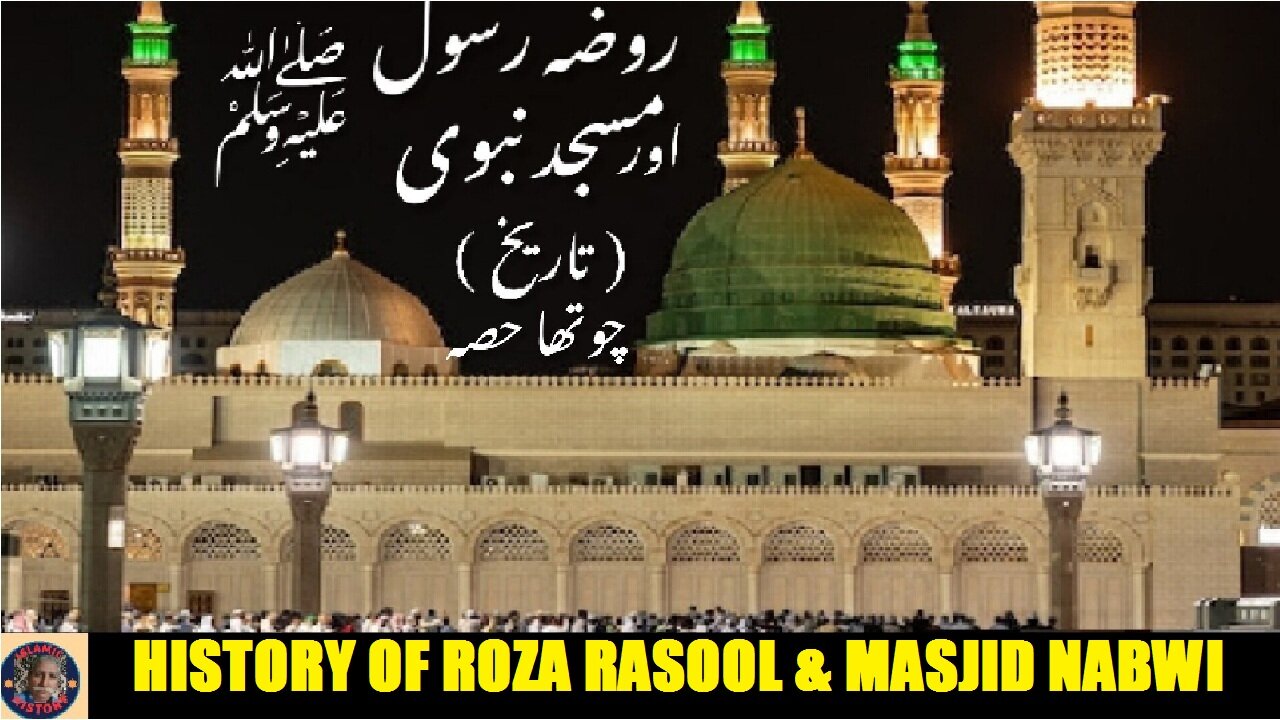Premium Only Content

Part-4 History of Roza Rasool and Masjid Nabwi روضہ رسول اور مسجد نبوی صلی اللہ علیہ وسلم کی تاریخ
@islamichistory813 #TombOfTheProphetMuhammad #SacredChamber #IslamicHistory #Madina
Part-4
History of Roza Rasool and Masjid Nabwi (Peace be upon Him)
Asslamoalaikum sisters brothers friends and elders, We are contineu going to start describing from where yesterday we was stop describing the Tomb (Roza Rasool) of the Prophet Muhammad SAW (The Sacred Chamber, its is fourth part of topic.
The graves were also described as being about “four inches above ground level” by Abu Bakr al-Ajri I.
When the walls were being rebuilt, or after the walls had already been rebuilt, the eastern wall of the Sacred Chamber collapsed. In order to rebuild the wall, a foundation had to be dug whereupon a discovery was made. Urwah ibn Zubayr I narrates:
When the wall fell on them (i.e. graves) during the caliphate of al-Walid bin Abdul Malik, the people started repairing it, and a foot appeared to them. The people got scared and thought that it was the foot of the Prophet. No one could be found who could tell them about it until I (Urwa) said to them, ‘By Allah, this is not the foot of the Prophet (?) but it is the foot of Umar.’13
Abdullah ibn Muhammad ibn Aqeel ibn Abi Talib I gives his account of the collapse of this wall:
I would come to the Masjid Nabawi in the latter part of the night, where I would greet the Prophet and remain in the mosque until Fajr salah. During one rainy night, when I was near the house of al-Mughirah ibn Shu?bah, I smelt a fragrance which I had never come across before. I entered the mosque and greeted the Prophet, before being surprised to see that one of the walls of the Sacred Chamber had collapsed. I went inside the chamber and once again greeted the Prophet. Shortly after, Umar ibn Abdul Aziz, the Governor of Madinah, arrived after having been informed about the collapse of the wall. He ordered the Sacred Chamber to be covered with a large piece of cloth. In the morning, a builder was summoned and told to go inside the chamber. The builder requested another person to accompany him. Umar ibn Abdul Aziz and Qasim ibn Muhammad ibn Abu Bakr volunteered. Salim ibn Abdullah ibn Umar also volunteered. Umar ibn Abdul Aziz said, ‘We shouldn’t disturb the residents of these graves by crowding.’ Umar then instructed his freed slave, Muzahim to enter the room alone. Muzahim said, ‘The first grave is slightly lower in height than the other two graves.’ After the completion of the renovation, Umar instructed Muzahim to go inside again to clean the Sacred Chamber. Muzahim went in again and did the cleaning after the renovation had been completed. Later on Umar remarked, ‘I wish I had done the cleaning instead of Muzahim. This cleaning would have been better for me than all of my worldly assets.14
Umar ibn Abdul Aziz then rebuilt the walls with stones similar to the black stones of the Ka‘ba. These walls were about 6.5 metres high and had no windows or doors, so the graves became inaccessible. Furthermore, a pentagonal structure was erected around the inner wall. The reason why this wall was built in this peculiar way was because they wanted to prevent people from thinking that the Sacred Chamber, which may have now resembled the Kaaba, was another Kaaba in Madinah.
After the First Major Fire – 654 AH (1256 CE)
In 645 AH (1256 CE), a great fire caused by a candle or oil lamp ravaged Masjid Nabawi, destroying the vast majority of it, although the tomb of the Prophet ? remained preserved. However, the roof had collapsed onto the pentagonal structure built by Umar ibn Abdul Aziz I centuries earlier. After the fire, the residents of Madinah sought the assistance of the Abbasid Caliph, Al-Musta’sim Billah V, who was in Baghdad. However, the Caliph was preoccupied with the Mongol invasion of Baghdad and was unable to focus entirely on the reconstruction of Masjid Nabawi. Other Muslim leaders then assisted with the reconstruction of Masjid Nabawi, although nobody was willing to touch the pentagonal structure or clear the debris on top of it or inside of it out of respect for its sanctity, so it was left in that state. Temporary wooden roofing and five layers of cloth were used to shelter the Prophet’s ? tomb for several years.
Enclosure Built Around the Tomb – 668 AH (1269 CE)
Al-Zahir Baybars V was an eminent Mamluk Sultan of Egypt who defeated the Mongol army that had previously killed scores of Muslims. For the first time in the history of Masjid Nabawi, the Sultan built a wooden enclosure around the tomb of the Prophet ? and the house of Fatima and Ali L. This railing marked the boundary where visitors could face the Prophet ? and his two companions. At the time, it was three metres in height and had three doors – one to the east, one to the west and another to the south. Sultan Baybars took the measurements himself during a visit to Madinah before ordering the wood from Egypt. This boundary still exists and is demarcated today by the golden grill where visitors greet the Prophet ? and his companions. Part of the Rawdah, adjacent to the tomb of Prophet ? is also included within this boundary.
Dome Built for the First Time – 678 AH (1279 CE)
In 678 AH (1279 CE), the Mamluk Sultan, Al-Mansur Qalawun V, was the first to build a dome over the Sacred Chamber. It was made from wood and covered with lead. The base was rectangular, and the upper section was octagonal.
Repair Work – 881 AH (1476 CE)
In 881 AH (1476 CE), the Mamluk Sultan of Egypt, Al-Ashraf Qaitbay V, started significant reconstruction work of Masjid Nabawi. Entire sections of the Masjid were pulled down and rebuilt. Repair work was carried out on the walls of the Prophet’s ? tomb, which were rebuilt using stone after they developed cracks during the first major fire. The ceiling of the inner chamber was raised, and the wooden dome was replaced with one made from stone. The floor of the Sacred Chamber was also replaced with red and white marble.
After the Second Major Fire – 886 AH (1481 CE)
In Ramadan of 886 AH (1481 CE), the second major fire broke out in Masjid Nabawi after a lightning bolt struck a minaret, causing it to come crashing down on the roof of the mosque and killing the Mu’addhin. The fire started on the roof and quickly spread to other parts of the masjid, even spreading to neighbouring houses, such was its ferocity. The people of Madinah tried their best to put out the fire, which claimed the lives of several people. Sultan Qaitbay ordered a complete restoration of Masjid Nabawi and also ordered that the tomb of the Prophet ? be cleaned.
So dear friends, remaining history will be described from here in next video part-5. Allah Hafiz
=====================================
-
 38:41
38:41
Sarah Westall
14 hours agoHealth Freedom Under Attack, Dr Robert Young Found Guilty on Suspicious Victimless Crime, Matt Hazen
96.6K9 -
 LIVE
LIVE
Vigilant News Network
13 hours agoDataRepublican Exposes the Shadow Government’s Darkest Secrets - Exclusive Interview | Media Blackout
2,000 watching -
 31:39
31:39
Peter Santenello
1 year agoStories From Vegas' Golden Era 🇺🇸
92.8K24 -
 LIVE
LIVE
The Why Files
16 hours agoLIVE: The Why Files 24/7 Stream n' Chat
1,366 watching -
 55:15
55:15
Russell Brand
1 day agoThe Truth About Big Pharma & COVID with Dr. Aseem Malhotra
194K12 -
 1:19:48
1:19:48
The Rubin Report
17 hours agoWhat the Trump Administration Must Do Instead of Revenge | Peter Thiel
146K173 -
 1:59:00
1:59:00
Steve-O's Wild Ride! Podcast
3 days ago $38.58 earnedPatrick Bet-David DESTROYS Steve-O's Dad - Wild Ride #252
160K57 -
![[XboxONE] GRINDING 1000g FC24](https://1a-1791.com/video/fwe1/01/s8/1/y/k/I/o/ykIoy.0kob-small-XboxONE-GRINDING-1000g-FC24.jpg) 3:29:15
3:29:15
deathbee
20 hours ago[XboxONE] GRINDING 1000g FC24
108K7 -
 1:08:32
1:08:32
Winston Marshall
1 day agoThe HIDDEN Agenda: Congresswoman Hageman UNCOVERS USAID Fraud, Censorship and Human Trafficking
134K154 -
 8:16
8:16
CarlCrusher
1 day agoThe True Story of Stranger Things and the Montauk Project Origins
81.8K25